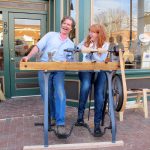We may receive a commission when you use our affiliate links. However, this does not impact our recommendations.
Years ago, when I was woodworking as a full-time occupation, I remember a couple jobs in particular that required me to set up a drill press to drill a sequence of holes where accuracy was a must. One job was producing prototype cabinets for JBL, the company that makes speakers. The cabinets were intended to be “knock down” so fasteners could be inserted and align perfectly for assembly. The blueprints they supplied called out hole centers like 7.312″ then 12.855″. There were dozens of these. This job is where I became familiar with dial calipers. I also took some advice from a more experienced woodworker. I complained to him about working to such finicky dimensions. He said, “If you can drill precisely to 5″ or 10 3/4″ then you can drill precisely to any number expressed in thousands of an inch.” Point taken.
The second job, which lead me reconsider self-employment as a cabinetmaker, was constructing 13 weaving looms ranging in size from a smaller tabletop model to large floor models with five harnesses, you know, the kind you sit at. It was the job of 10,000 holes for each one, or so it seemed. Ugh!
I recently built a drill press table for our shop that was in the April issue. As part of that story I posted a short video on the subject of how to drill repetitive hole patterns with a high degree of accuracy. This may not break new ground for some of you, but I suspect there are others who will find it helpful.
Here are some supplies and tools we find essential in our everyday work around the shop. We may receive a commission from sales referred by our links; however, we have carefully selected these products for their usefulness and quality.










One note about using multiple stop blocks. If each one is just a tad long, then stacking them up makes the error multiply. This is especially noticeable when you have a lot of blocks, such as when you need to drill 20 holes in a row, for example. If each block is just 1/64″ (0.015″)long, you would be off 5/16″ at the last hole! Cumulative error is the proper term.
A more accurate way is to make a separate block for each hole position. So, you still have 20 blocks to make, but if each one is 1/64″ off, then any hole is only 1/64″ off.
“This may not break new ground for some of you, but I suspect there are others who will find it helpful.”
No matter how experienced any of us may be, there is always something to be learned. Thanks, Steve, for a very helpful video.
Really like the stop blocks, but please put a lapel mike on someone in your new workshop. It is more 55 gallon barrel than Carnegie Hall.
Great stuff Steve, keep the videos comming!
Steve, great video. I agree with Dave that the stop block pieces is what made the video tip. I have used stop blocks for years but never thought about relieving a portion as you did. Thank you.
The stop block details really make this a great video tip.